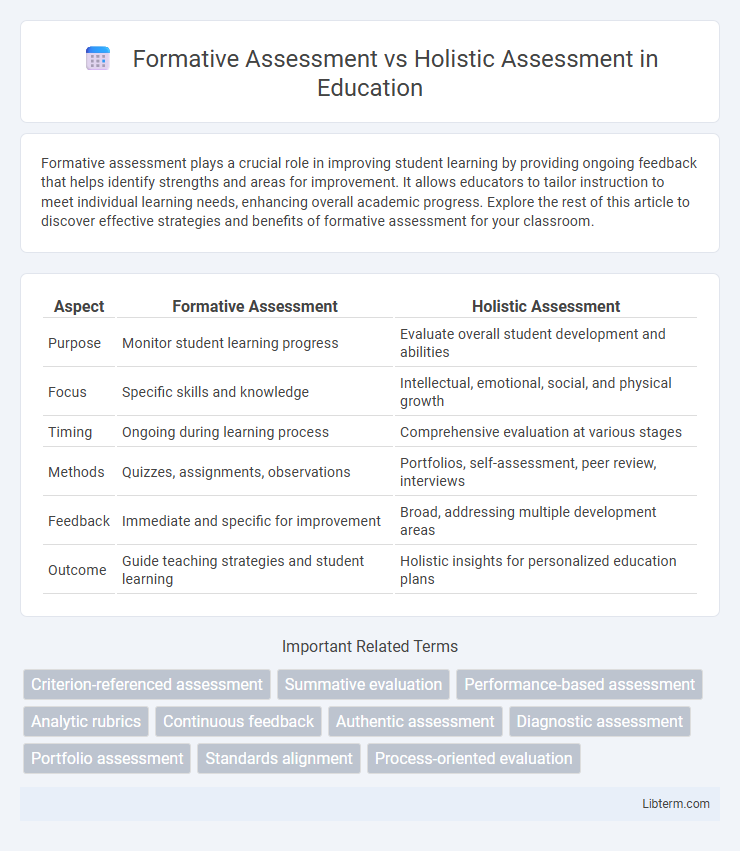Formative assessment plays a crucial role in improving student learning by providing ongoing feedback that helps identify strengths and areas for improvement. It allows educators to tailor instruction to meet individual learning needs, enhancing overall academic progress. Explore the rest of this article to discover effective strategies and benefits of formative assessment for your classroom.
Table of Comparison
| Aspect | Formative Assessment | Holistic Assessment |
|---|---|---|
| Purpose | Monitor student learning progress | Evaluate overall student development and abilities |
| Focus | Specific skills and knowledge | Intellectual, emotional, social, and physical growth |
| Timing | Ongoing during learning process | Comprehensive evaluation at various stages |
| Methods | Quizzes, assignments, observations | Portfolios, self-assessment, peer review, interviews |
| Feedback | Immediate and specific for improvement | Broad, addressing multiple development areas |
| Outcome | Guide teaching strategies and student learning | Holistic insights for personalized education plans |
Introduction to Formative and Holistic Assessment
Formative assessment involves continuous evaluation during the learning process, focusing on identifying students' strengths and areas for improvement to guide instruction. Holistic assessment evaluates a learner's overall development by considering cognitive, emotional, social, and physical dimensions rather than isolated skills or knowledge. Both approaches prioritize comprehensive student growth but differ in timing and scope of evaluation.
Defining Formative Assessment
Formative assessment refers to ongoing evaluations conducted during the learning process to monitor student understanding and provide immediate feedback for improvement. It emphasizes identifying specific learning gaps and adjusting instruction accordingly to enhance student performance. This type of assessment is integral to personalized learning and skill development in educational settings.
Understanding Holistic Assessment
Holistic assessment evaluates learners' overall development by considering cognitive, emotional, and social dimensions, rather than isolated skills or knowledge. Unlike formative assessment, which provides ongoing feedback to improve specific learning outcomes, holistic assessment captures a comprehensive picture of student growth and competencies in real-world contexts. This approach prioritizes integrated performance and the interconnectedness of learning experiences over segmented evaluation criteria.
Key Differences Between Formative and Holistic Assessment
Formative assessment focuses on ongoing feedback and specific skill development during the learning process, allowing teachers to adjust instruction based on student performance. Holistic assessment evaluates the overall understanding and application of knowledge by considering multiple aspects such as critical thinking, creativity, and problem-solving in a comprehensive manner. Key differences include formative assessment's emphasis on detailed, incremental progress tracking, whereas holistic assessment captures broader learning outcomes and student growth over time.
Advantages of Formative Assessment
Formative assessment offers real-time feedback that enables educators to identify student learning gaps and tailor instruction promptly, enhancing overall academic performance. This approach fosters active student engagement, encourages self-reflection, and promotes continuous improvement through iterative assessments. By focusing on specific skills and knowledge incrementally, formative assessment supports personalized learning paths and improves long-term retention.
Benefits of Holistic Assessment
Holistic assessment offers a comprehensive evaluation of a learner's abilities by integrating cognitive, emotional, and social dimensions, which enhances the understanding of overall development beyond mere academic performance. It supports personalized learning by addressing diverse skills and strengths, promoting growth in critical thinking, creativity, and interpersonal skills. This approach encourages self-reflection and meaningful feedback, fostering lifelong learning and motivation more effectively than formative assessment alone.
Challenges of Formative and Holistic Assessments
Formative assessment challenges include time constraints, teacher bias, and difficulty in providing immediate, individualized feedback, which can hinder timely learning adjustments. Holistic assessment faces challenges in standardization, subjective judgment, and complexity in evaluating diverse skills and competencies comprehensively. Both approaches demand significant educator training and resources to ensure effectiveness and reliability in diverse educational settings.
Practical Applications in the Classroom
Formative assessment involves ongoing evaluations such as quizzes, observations, and feedback sessions, enabling teachers to adjust instruction in real time and support student learning effectively. Holistic assessment evaluates the overall student performance by integrating multiple aspects of learning, including critical thinking, creativity, and collaboration, often through portfolios or comprehensive projects. Practical classroom application combines formative assessments to identify learning gaps regularly and holistic assessments to capture the full spectrum of student growth and competencies over time.
Choosing the Right Assessment Approach
Choosing the right assessment approach depends on educational goals, with formative assessment emphasizing ongoing feedback to improve student learning and holistic assessment evaluating overall development, including social, emotional, and cognitive skills. Formative assessment provides detailed insights into specific skill mastery during the learning process, while holistic assessment offers a broader picture of student growth and competencies. Educators often combine both methods to balance targeted academic improvement with comprehensive development.
Conclusion: Integrating Assessment Methods for Optimal Learning
Integrating formative assessment and holistic assessment methods creates a comprehensive evaluation framework that supports continuous learner development and addresses multiple dimensions of student performance. Formative assessment provides ongoing feedback for immediate improvement, while holistic assessment captures the broader cognitive, emotional, and social aspects of learning. Combining these approaches enhances instructional effectiveness and promotes deeper, more personalized educational outcomes.
Formative Assessment Infographic

 libterm.com
libterm.com